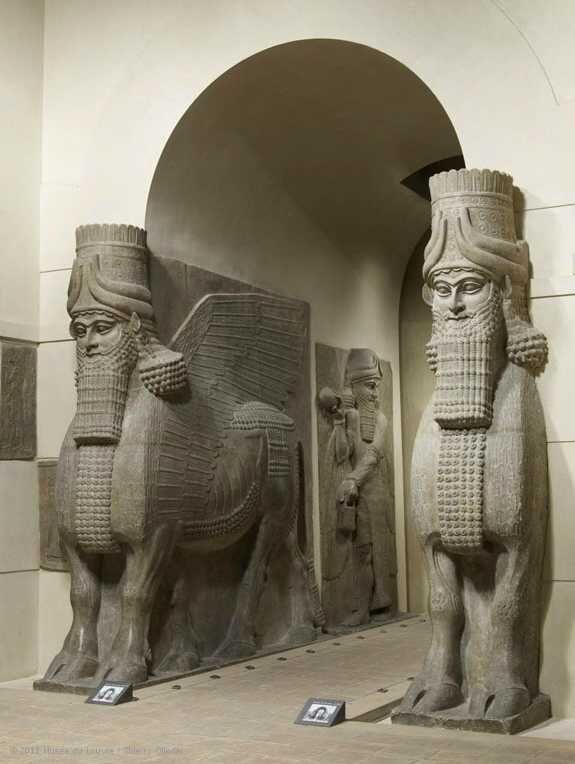The Lamassu sculptures were recovered from where. Where were the lamassu sculptures originally displayed.

Lamassu From The Citadel Of Sargon Ii Video Khan Academy
Currently representations of Lamassu are parts of collections at the British Museum in London Metropolitan Museum of Art in New York and The Oriental Institute in Chicago.
. It documents the story of human culture from its beginnings to the present. What were the most common themes in Assyrian art. The palace stood pairs of powerful mythological creatures known as lamassu Gates 170-171.
Strengthening these bonds further were the so-called Panhellenic sanctuaries and festivals that embraced all Greeks and encouraged interaction competition and exchange for example the Olympics which were held at the Panhellenic. Click to see full answer. You can see them at Gate of All Nations at Persepolis in Iran the British Museum in London the Louvre in Paris the National Museum of Iraq in Baghdad the Metropolitan Museum of Art in New York and the University of Chicago Oriental Institute.
The Lamassu seen from the side from the palace Sargon II r. The lamassu of Ashurnasirpals Northwest palace were enormous stone-carved sculptures with the head of a human and displayed animal-like features including the wings of a bird and the body of a bull. Where were the lamassu sculptures originally displayed.
Furthermore where were the lamassu sculptures originally displayed. 721-705 BCE Part of a collection at the Louvre in Paris France. Assyrian sculpture typically placed prominent pairs of lamassu at entrances in palaces facing the street and also internal courtyards.
The most famous colossal statues of Lamassu have been excavated at the sites of the Assyrian capitals established by King Assurnasirpal II reigned 883 859 BCE and King Sargon II reigned 721 705 BCE. An American professor named Michael Rakowitz was commissioned to recreate this Lamassu sculpture and it is now displayed in Trafalgar Square in London. The Lamassu sculptures were recovered from where.
The Ziggurat at Ur was a fortress funerary monument palace temple platform Where were the Lamassu sculptures originally displayed. The Lamassu sculptures were recovered from where. Which work has a king approaching the god.
The Ziggurat at Ur was a fortress funerary monument palace temple platform Where were the Lamassu sculptures originally displayed. From what we can tell it seems that these sculptures were believed to protect the palace and king from evil supernatural forces as well. Which work has a king approaching the god Shamash.
Lamassu the were. Appreciating and understanding ancient Egyptian art. These massive sculptures served as symbolic guards of Assyrian kings domain being placed at the entrance to both the city and palace gateways See Collins 2008 72.
The British Museum was the first public national museum in the world. In the Assyrian mythology there were human headed winged bullslions that were protective genies. Hermaphroditus was actually a popular subject of paintings and statuary even if Written By whitehouse March 11 2022 Add Comment Edit.
Originally unearthed in Rome and displayed in the Borghese Gallery it was sold to the occupying French and now sits in the Louvre. What ethnic group is credited with the first system of writing known to man. In some cases the lamassu statues were accompanied by.
Where were the Lamassu sculptures originally displayed. A Sargons palace b Gudeas Lagash c Ashurbanipals palace d Ziggurat at Ur Which of the following played an important role in the shaping of modern art. The Assyrians envisioned a protective spirit that was part bull and part human.
Ditulis Joyce Guerrero Maret 22 2022 Tulis Komentar Edit. Ashurnasirpal Essay 1619 Words 7 Pages. Originally unearthed in Rome and displayed in the Borghese Gallery it was sold to the occupying French and now sits in the Louvre.
Colossal Lamassu Sculpture From The Palace Of Sargon Ii At Khorsabad Sargon Ii Google Arts Culture Human Headed Winged Bull Lamassu Assyrian Neo Assyrian The Metropolitan Museum Of Art Share this post. Which is the oldest site for town planning. The gate and its lamassu were first excavated by Sir Austen Henry Layard in 1849 but then re-buried.
Learn vocabulary terms and more with flashcards games and other study tools. The shelves on which the dead were placed in Early Christian catacombs were called. The Ziggurat at Ur was a fortress funerary monument palace temple platform Where were the Lamassu sculptures originally displayed.
The first change was the capital was moved to Dur Sharrukin present day Khorsabad and second the Lamassu was presented on a bulls body compared to a lions and seems to be slightly smiling. This replica was made with 10000 Iraqi date syrup cans and serves as a symbol of bright colors in the dark gray area of London. Start studying Art History Studying.
What ethnic group is credited with the first system of writing known to man. The Assyrians envisioned a protective spirit that was part bull and part human and sometimes part eagle. This was possibly the first time when Europeans watched the mythical monsters.
Originally unearthed in Rome and displayed in the Borghese Gallery it was sold to the occupying French and now sits in the Louvre. Best tattoo shop in san antonio tx. The first change was the capital was moved to Dur Sharrukin present day Khorsabad and second the Lamassu was presented on a bulls body compared to a lions and seems to be slightly smiling.
They were represented as double-aspect figures on corners in high relief. What color is lapis lazuli.

Art History Blogger Assyrian Art And The Lamassu Sculpture

Lamassu History 2701 Wiki Fandom

Lamassu Backstory Article Assyrian Khan Academy

Lamassus At The Louvre Thatmuse
Human Headed Winged Lion Lamassu Assyrian Neo Assyrian The Metropolitan Museum Of Art
Human Headed Winged Bull Lamassu Assyrian Neo Assyrian The Metropolitan Museum Of Art
Colossal Lamassu Sculpture From The Palace Of Sargon Ii At Khorsabad Sargon Ii Google Arts Culture

25 Lamassu From The Citadel Of Sargon Ii Dur Sharrukin Modern Iraq Ap Art History
0 comments
Post a Comment